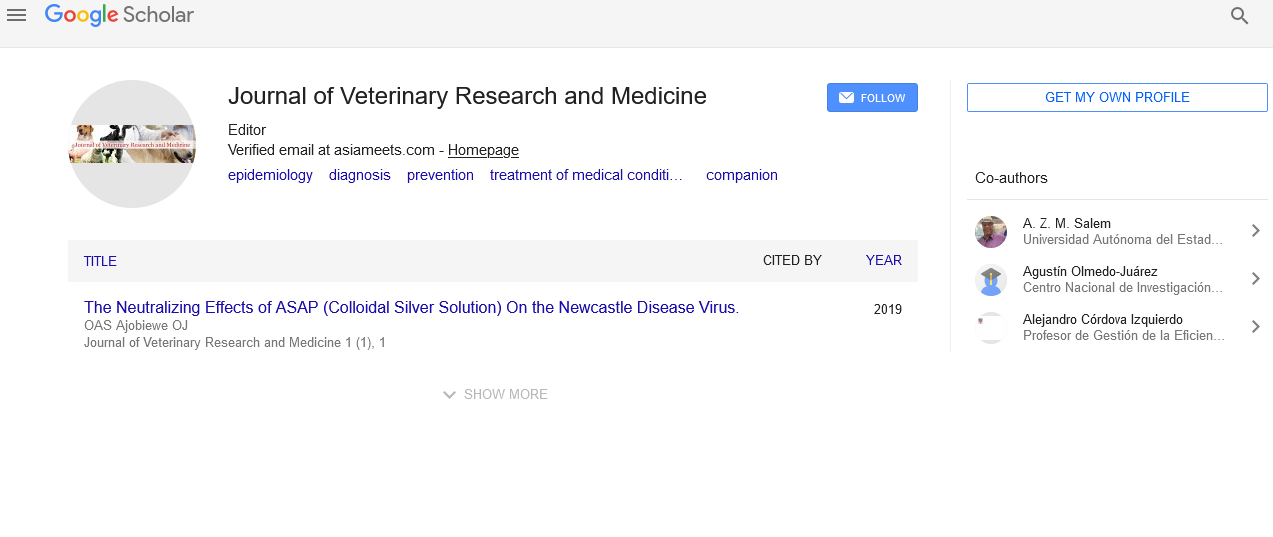Oxidative stress and cognitive dysfunction syndrome in cats
Received: 01-Apr-2022, Manuscript No. PULJVRP-22-4701(R); Editor assigned: 02-Apr-2022, Pre QC No. PULJVRP-22-4701(PQ); Accepted Date: Apr 09, 2022; Reviewed: 05-Apr-2022 QC No. PULJVRP-22-4701(Q); Revised: 08-Apr-2022, Manuscript No. PULJVRP-22-4701; Published: 13-Apr-2022
Citation: Penna B. Oxidative stress and cognitive dysfunction syndrome in cats. J Vet Res Med. 2022;4(2): 01.
This open-access article is distributed under the terms of the Creative Commons Attribution Non-Commercial License (CC BY-NC) (http://creativecommons.org/licenses/by-nc/4.0/), which permits reuse, distribution and reproduction of the article, provided that the original work is properly cited and the reuse is restricted to noncommercial purposes. For commercial reuse, contact reprints@pulsus.com
Abstract
The future of our pets has expanded altogether lately, on account of progress in veterinary medication, improvement in everyday cleanliness and better nourishment. Maturing is described by a dynamic decrease in the proficiency of physiological capacity and by the expanded helplessness to infection and demise. Presently, one of the most conceivable and adequate clarifications for the robotic premise of maturing is the free extreme hypothesis of maturing. This hypothesis proposes that maturing, its connected sicknesses are the outcome of free-revolutionary actuated harm to cell macromolecules and the failure to offset these progressions by endogenous cancer prevention agent protections. The free-revolutionary hypothesis of maturing arose in the mid1950s. This hypothesis recommended that free revolutionaries delivered during vigorous breath perniciously affects cell parts also, connective tissues, causing aggregate harm after some time that at last outcomes in maturing and demise.
Key Words
Feline; Oxidative Stress; Cognition
Introduction
Twariness first spread around this hypothesis was debilitated by the disclosure in 1969 of the catalyst Superoxide Dismutase (SOD). Besides, the body’s capacity to keep up with homeostasis and adjust to outer impacts step by step modifies with age. Felines age all the more leisurely and, dissimilar to canines, there are no distinctions concurring to raise. Future of homegrown felines is somewhere in the range of 14 and 20 years. As indicated by the most recent details made by FAB (Feline Warning Bureau, UK) or the American Association of Feline Experts, a feline can be viewed as moderately aged when it is somewhere in the range of 7 and 10 years of age; senior when it is between 11-14 and geriatric from 15 years.
The expanded rates old enough related sicknesses regularly results in conduct changes, however isn’t connected all the time to cognizance. Cognizance, as far as creature conduct, alludes to mental cycles that can’t be noticed straight forwardly. This incorporates memory, learning, awareness and discernment. These processes permit creatures to arrange themselves in space, create propensities and acknowledgment and response to human relatives.
A reviewed survey on older cats (matured 7-11 years) uncovered that 36% of owners announced conduct issues in their cats and this increased to 88% in felines matured between 16-19 years. A later review proposed 28% of pet cats matured 11-14 years develop no less than one geriatric-beginning conduct issue, and this expanded to 50% for cats of 15 years or more. In pets, degenerative dementia affecting brain cortex is called Cognitive Dysfunction Syndrome (CDS) and is defined as an age-related neurodegenerative disorders resulting from a decline in brain functions, including those affecting memory and learning.
Background
All oxygen consuming organic entities are vulnerable to oxidative pressure just in light of the fact that semi-diminished oxygen species, superoxide and hydrogen peroxide, are delivered mostly by mitochondria during breath. Different wellsprings of free revolutionaries are lysosomes, endoplasmic reticulum, endosomes, peroxisomes and the core. Mitochondrial DNA is consistently presented to a constant flow of Reactive Oxygen Species that are created as results during the exchange of electrons to atomic oxygen. The pace of mitochondrial creation of Reactive Oxygen Species increments with age, though focuses of mitochondrial cell reinforcements diminishes. The outcome is oxidative harm to mitochondrial DNA, with the degree of the harm expanding dramatically with age, which prompts disabled electron transport and expanded spillage of Reactive Oxygen Species from the electron transport chain, making an endless loop of destruction.
Other than oxygen, nitrogen likewise assumes a significant part harming organic particles by means of responsive nitrogen species, counting both revolutionary and non-extremist constructions. Receptive Nitrogen Species (RNS) are different nitric oxide-inferred compounds, including nitroxyl anion, nitrosonium cation and higher oxides of nitrogen, S-nitrosothiols, and dinitrosyl iron buildings. RNS have been perceived as assuming a critical part in the physiologic guideline of many, while perhaps not every, living cell, such as smooth muscle cells, cardio myocytes, platelets, and juxtaglomerular cell. They have pleiotropic properties on cell focuses after both post - translational changes and associations with Reactive Oxygen Species (ROS). Raised levels of RNS have been ensnared in cell injury and passing by inciting nitrosative pressure.
Conclusion
Specific clinical trials are needed to design helpful therapeutic interventions in cats. However, the first step is to obtain a reliable tool enabling early diagnosis of the disease. Hitherto, the evaluation of oxidative stress may be considered more as a preventative assessment than a diagnostic tool. Even so, the evaluation of oxidative stress and its factors of variation with age allow us to monitor the success - or failure - of the many nutritional and pharmacological strategies that exist in Feline Medicine today





